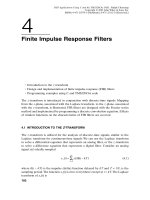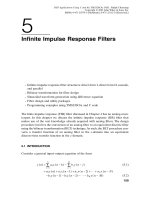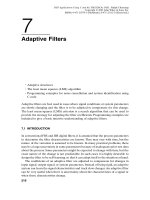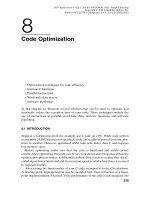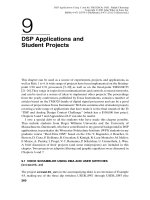DSP applications using C and the TMS320C6X DSK (P6)
Bạn đang xem bản rút gọn của tài liệu. Xem và tải ngay bản đầy đủ của tài liệu tại đây (374.78 KB, 34 trang )
6
Fast Fourier Transform
182
•
The fast Fourier transform using radix-2 and radix-4
•
Decimation or decomposition in frequency and in time
•
Programming examples
The fast Fourier transform (FFT) is an efficient algorithm that is used for convert-
ing a time-domain signal into an equivalent frequency-domain signal, based on the
discrete Fourier transform (DFT). Several real-time programming examples on FFT
are included.
6.1 INTRODUCTION
The discrete Fourier transform converts a time-domain sequence into an equivalent
frequency-domain sequence. The inverse discrete Fourier transform performs the
reverse operation and converts a frequency-domain sequence into an equivalent
time-domain sequence. The fast Fourier transform (FFT) is a very efficient algo-
rithm technique based on the discrete Fourier transform but with fewer computa-
tions required. The FFT is one of the most commonly used operations in digital
signal processing to provide a frequency spectrum analysis [1–6]. Two different
procedures are introduced to compute an FFT: the decimation-in-frequency and
the decimation-in-time. Several variants of the FFT have been used, such as the
Winograd transform [7,8], the discrete cosine transform (DCT) [9], and the discrete
Hartley transform [10–12]. Programs based on the DCT, FHT, and the FFT are avail-
able in Ref. 9.
DSP Applications Using C and the TMS320C6x DSK. Rulph Chassaing
Copyright © 2002 John Wiley & Sons, Inc.
ISBNs: 0-471-20754-3 (Hardback); 0-471-22112-0 (Electronic)
6.2 DEVELOPMENT OF THE FFT ALGORITHM WITH RADIX-2
The FFT reduces considerably the computational requirements of the discrete
Fourier transform (DFT). The DFT of a discrete-time signal x(nT) is
(6.1)
where the sampling period T is implied in x(n) and N is the frame length. The
constants W are referred to as twiddle constants or factors, which represent the
phase, or
(6.2)
and is a function of the length N. Equation (6.1) can be written for k = 0,1,...,
N - 1, as
(6.3)
This represents a matrix of N ¥ N terms, since X(k) needs to be calculated for N
values for k. Since (6.3) is an equation in terms of a complex exponential, for each
specific k there are (N - 1) complex additions and N complex multiplications. This
results in a total of (N
2
- N) complex additions and N
2
complex multiplications.
Hence, the computational requirements of the DFT can be very intensive, especially
for large values of N. FFT reduces computational complexity from N
2
to NlogN.
The FFT algorithm takes advantage of the periodicity and symmetry of the
twiddle constants to reduce the computational requirements of the FFT. From the
periodicity of W,
W
k+N
= W
k
(6.4)
and from the symmetry of W,
(6.5)
Figure 6.1 illustrates the properties of the twiddle constants W for N = 8. For
example, let k = 2, and note that from (6.4), W
10
= W
2
, and from (6.5), W
6
=-W
2
.
For a radix-2 (base 2), the FFT decomposes an N-point DFT into two (N/2)-point
or smaller DFTs. Each (N/2)-point DFT is further decomposed into two (N/4)-point
DFTs, and so on. The last decomposition consists of (N/2) two-point DFTs. The
smallest transform is determined by the radix of the FFT. For a radix-2 FFT, N must
be a power or base of 2, and the smallest transform or the last decomposition is the
two-point DFT. For a radix-4, the last decomposition is a four-point DFT.
WW
kN k+
=-
2
Xk x x W x W xN W
kk
Nk
()
=
()
+
()
+
()
++ -
()
-
()
01 2 1
2
1
...
We
jN
=
- 2p
Xk xnW k N
nk
n
N
()
=
()
=-
=
-
Â
0
1
01 1, ,...,
Development of the FFT Algorithm with Radix-2
183
184
Fast Fourier Transform
6.3 DECIMATION-IN-FREQUENCY FFT ALGORITHM WITH RADIX-2
Let a time-domain input sequence x(n) be separated into two halves:
(a) (6.6)
and
(b) (6.7)
Taking the DFT of each set of the sequence in (6.6) and (6.7) gives us
(6.8)
Let n = n + N/2 in the second summation of (6.8); X(k) becomes
(6.9)
where W
kN/2
is taken out of the second summation because it is not a function of
n. Using
Wee j
kN
jk j
k
k
k
2
1==
()
=-
()
=-
()
--pp
ppcos sin
Xk xnW W xn
N
W
nk kN
n
N
nk
n
N
()
=
()
++
Ê
Ë
ˆ
¯
=
()
-
=
()
-
ÂÂ
2
0
21
0
21
2
Xk xnW xnW
nk
n
N
nk
nN
N
()
=
()
+
()
=
()
-
=
-
ÂÂ
0
21
2
1
N
x
N
xN
22
11
Ê
Ë
ˆ
¯
+
Ê
Ë
ˆ
¯
-
()
, ,...,
xx x
N
01
2
1
() ()
-
Ê
Ë
ˆ
¯
, ,...,
W
3
= W
11
=
…
W
4
= W
12
=
…
W
0
= W
8
=
…
W
5
= W
13
=
…
W
7
= W
15
=
…
W
2
= W
10
=
…
W
6
= W
14
=
…
W
1
= W
9
=
…
FIGURE 6.1. Periodicity and symmetry of twiddle constant W.
in (6.9), X(k) becomes
(6.10)
Because (-1)
k
= 1 for even k and -1 for odd k, (6.10) can be separated for even and
odd k,or
1. For even k:
(6.11)
2. For odd k:
(6.12)
Substituting k = 2k for even k, and k = 2k + 1 for odd k, (6.11) and (6.12) can be
written for k = 0,1,...,(N/2) - 1 as
(6.13)
(6.14)
Because the twiddle constant W is a function of the length N, it can be represented
as W
N
. Then W
2
N
can be written as W
N/2
. Let
(6.15)
(6.16)
Equations (6.13) and (6.14) can be written more clearly as two (N/2)-point DFTs, or
(6.17)
(6.18)
Figure 6.2 shows the decomposition of an N-point DFT into two (N/2)-point DFTs,
for N = 8. As a result of the decomposition process, the X’s in Figure 6.2 are even
Xk bnWW
n
N
N
n
N
nk
21
0
21
2
+
()
=
()
=
()
-
Â
Xk anW
n
N
N
nk
2
0
21
2
()
=
()
=
()
-
Â
bn xn xn N
()
=
()
-+
()
2
an xn xn N
()
=
()
++
()
2
xk xn xn
N
WW
n
N
nnk
21
2
0
21
2
+
()
=
()
-+
Ê
Ë
ˆ
¯
È
Î
Í
˘
˚
˙
=
()
-
Â
Xk xn xn
N
W
n
N
nk
2
2
0
21
2
()
=
()
++
Ê
Ë
ˆ
¯
È
Î
Í
˘
˚
˙
=
()
-
Â
Xk xn xn
N
W
n
N
nk
()
=
()
-+
Ê
Ë
ˆ
¯
È
Î
Í
˘
˚
˙
=
()
-
Â
2
0
21
Xk xn xn
N
W
n
N
nk
()
=
()
++
Ê
Ë
ˆ
¯
È
Î
Í
˘
˚
˙
=
()
-
Â
2
0
21
Xk xn xn
N
W
k
n
N
nk
()
=
()
+-
()
+
Ê
Ë
ˆ
¯
È
Î
Í
˘
˚
˙
=
()
-
Â
1
2
0
21
Decimation-in-Frequency FFT Algorithm with Radix-2
185
186
Fast Fourier Transform
in the upper half and odd in the lower half. The decomposition process can now be
repeated such that each of the (N/2)-point DFTs is further decomposed into two
(N/4)-point DFTs, as shown in Figure 6.3, again using N = 8 to illustrate.
The upper section of the output sequence in Figure 6.2 yields the sequence X(0)
and X(4) in Figure 6.3, ordered as even. X(2) and X(6) from Figure 6.3 represent
the odd values. Similarly, the lower section of the output sequence in Figure 6.2
yields X(1) and X(5), ordered as the even values, and X(3) and X(7) as the odd
values. This scrambling is due to the decomposition process. The final order of the
FIGURE 6.2. Decomposition of N-point DFT into two (N/2)-point DFTs, for N = 8.
FIGURE 6.3. Decomposition of two (N/2)-point DFTs into four (N/4)-point DFTs, for
N = 8.
Decimation-in-Frequency FFT Algorithm with Radix-2
187
output sequence X(0), X(4),...in Figure 6.3 is shown to be scrambled. The output
needs to be resequenced or reordered. Programming examples presented later in
this chapter include the appropriate function for resequencing.The output sequence
X(k) represents the DFT of the time sequence x(n).
This is the last decomposition, since we now have a set of (N/2) two-point DFTs,
the lowest decomposition for a radix-2. For the two-point DFT, X(k) in (6.1) can be
written as
(6.19)
or
X(0) = x(0)W
0
+ x(1)W
0
= x(0) + x(1) (6.20)
X(1) = x(0)W
0
+ x(1)W
0
= x(0) - x(1) (6.21)
since W
1
= e
-j2p/2
=-1. Equations (6.20) and (6.21) can be represented by the
flow graph in Figure 6.4, usually referred to as a butterfly. The final flow graph of
an eight-point FFT algorithm is shown in Figure 6.5. This algorithm is referred
as decimation-in-frequency (DIF) because the output sequence X(k) is decomposed
(decimated) into smaller subsequences, and this process continues through M stages
or iterations, where N = 2
M
. The output X(k) is complex with both real and imagi-
nary components, and the FFT algorithm can accommodate either complex or real
input values.
The FFT is not an approximation of the DFT. It yields the same result as the
DFT with fewer computations required. This reduction becomes more and more
important with higher-order FFT.
There are other FFT structures that have been used to illustrate the FFT. An
alternative flow graph to that in Figure 6.5 can be obtained with ordered output and
scrambled input.
An eight-point FFT is illustrated through the following exercise. We will see that
flow graphs for higher-order FFT (larger N) can readily be obtained.
Xk xnW k
nk
n
()
=
()
=
=
Â
0
1
01,
FIGURE 6.4. Two-point FFT butterfly.
188
Fast Fourier Transform
Exercise 6.1: Eight-Point FFT Using Decimation-in-Frequency
Let the input x(n) represent a rectangular waveform, or x(0) = x(1) = x(2) = x(3)
= 1 and x(4) = x(5) = x(6) = x(7) = 0. The eight-point FFT flow graph in Figure 6.5
can be used to find the output sequence X(k), k = 0,1,...,7.With N = 8, four twiddle
constants need to be calculated, or
W
0
= 1
The intermediate output sequence can be found after each stage.
Stage 1
x(0) + x(4) = 1 Æ x¢(0)
x(1) + x(5) = 1 Æ x¢(1)
x(2) + x(6) = 1 Æ x¢(2)
x(3) + x(7) = 1 Æ x¢(3)
[x(0) - x(4)]W
0
= 1 Æ x¢(4)
[x(1) - x(5)]W
1
= 0.707 - j0.707 Æ x¢(5)
[x(2) - x(6)]W
2
=-j Æ x¢(6)
[x(3) - x(7)]W
3
=-0.707 - j0.707 Æ x¢(7)
We j
j
3
68
0 707 0 707==--
-p
..
We j
j
2
48
==-
-p
We j j
j
1
28
4 4 0 707 0 707==
()
-
()
=-
-p
ppcos sin . .
FIGURE 6.5. Eight-point FFT flow graph using decimation-in-frequency.
where x¢(0), x¢(1),...,x¢(7) represent the intermediate output sequence after the
first iteration, which becomes the input to the second stage.
Stage 2
x¢(0) + x¢(2) = 2 Æ x≤(0)
x¢(1) + x¢(3) = 2 Æ x≤(1)
[x¢(0) - x¢(2)]W
0
= 0 Æ x≤(2)
[x¢(1) - x¢(3)]W
2
= 0 Æ x≤(3)
x¢(4) + x¢(6) = 1 - j Æ x≤(4)
x¢(5) + x¢(7) = (0.707 - j0.707) + (-0.707 - j0.707) = -j1.41 Æ x≤(5)
[x¢(4) - x¢(6)]W
0
= 1 + j Æ x≤(6)
[x¢(5) - x¢(7)]W
2
=-j1.41 Æ x≤(7)
The resulting intermediate, second-stage output sequence x≤(0), x≤(1),..., x≤(7)
becomes the input sequence to the third stage.
Stage 3
X(0) = x≤(0) + x≤(1) = 4
X(4) = x≤(0) - x≤(1) = 0
X(2) = x≤(2) + x≤(3) = 0
X(6) = x≤(2) - x≤(3) = 0
X(1) = x≤(4) + x≤(5) = (1 - j) + (-j1.41) = 1 - j2.41
X(5) = x≤(4) - x≤(5) = 1 + j0.41
X(3) = x≤(6) + x≤(7) = (1 + j) + (-j1.41) = 1 - j0.41
X(7) = x≤(6) - x≤(7) = 1 + j2.41
We now use the notation of X’s to represent the final output sequence. The values
X(0), X(1),..., X(7) form the scrambled output sequence. These results can be
verified with MATLAB, described in Appendix D. We show later how to reorder
the output sequence and plot the output magnitude.
Exercise 6.2: Sixteen-Point FFT
Given x(0) = x(1) = ...= x(7) = 1, and x(8) = x(9) = ...x(15) = 0, which represents
a rectangular input sequence. The output sequence can be found using the 16-point
flow graph shown in Figure 6.6. The intermediate output results after each stage
are found in a manner similar to that in Exercise 6.1. Eight twiddle constants W
0
,
W
1
,...,W
7
need to be calculated for N = 16.
Verify the scrambled output sequence X’s as shown in Figure 6.6. Reorder
this output sequence and take its magnitude. Verify the plot in Figure 6.7, which
Decimation-in-Frequency FFT Algorithm with Radix-2
189
stage 1 stage 2 stage 3 stage 4
1
1
1
1
1
1
1
1
1
1
1
1
1
1
1
1
1
0
0
0
0
8
0
0
0
0
0
0
0
4
4
0
0
0
0
0
0
0
2
2
2
2
0
0
0
0
0
0
0
x(0)
x(1)
x(2)
x(3)
x(4)
x(5)
x(6)
x(7)
x(8)
x(9)
x(10)
x(11)
x(12)
x(13)
x(14)
x(15)
W
1
W
2
W
2
W
4
W
6
W
2
W
4
W
4
W
4
W
4
W
4
W
6
W
3
W
4
W
5
W
6
W
7
0.923 - j
0.38
0.707 - j
0.707
-0.707 - j
0.707
0.38 - j
0.92
-0.38 - j
0.92
-j
-0.92 - j
0.38
-1.3 - j
0.54
-0.54 - j
1.3
0.54 - j
1.3
-j
2.61
-j
2.61
1.3 - j
0.54
1 + j
1 - j
1 - j
2.41
1 + j
2.41
1 + j
0.41
1 + j
0.2
1 - j
0.2
1 + j
1.496
1 - j
1.496
1 - j
0.41
1 - j
5.028
1 + j
5.028
X(15)
X(7)
X(11)
X(3)
X(13)
X(5)
X(9)
X(1)
X(14)
X(6)
X(10)
X(2)
X(12)
X(4)
X(8)
X(0)
1 - j
0.668
1 + j
0.668
- j
1.41
- j
1.08
- j
1.08
- j
1.41
-1
-1
-1
-1
-1
-1
-1
-1
-1
-1 -1
-1
-1
-1
-1
-1
-1
-1
-1
-1
-1
-1
-1
-1
-1
-1
-1
-1
-1
-1
-1
-1
FIGURE 6.6. Sixteen-point FFT flow graph using decimation-in-frequency.
190
Decimation-in-Time FFT Algorithm with Radix-2
191
represents a sinc function. The output X(8) represents the magnitude at the Nyquist
frequency. These results can be verified with MATLAB, described in Appendix D.
6.4 DECIMATION-IN-TIME FFT ALGORITHM WITH RADIX-2
Whereas the decimation-in-frequency (DIF) process decomposes an output se-
quence into smaller subsequences, the decimation-in-time (DIT) is a process that
decomposes the input sequence into smaller subsequences. Let the input sequence
be decomposed into an even sequence and an odd sequence, or
x(0), x(2), x(4),...,x(2n)
and
x(1), x(3), x(5),...,x(2n + 1)
We can apply (6.1) to these two sequences to obtain
(6.22)
Using W
2
N
= W
N/2
in (6.22) yields
(6.23)
which represents two (N/2)-point DFTs. Let
Xk xnW W xn W
N
nk
N
k
N
nk
n
N
n
N
()=
()
++
()
=
()
-
=
()
-
ÂÂ
221
22
0
21
0
21
Xk x nW x n W
nk
nk
n
N
n
N
()=
()
++
()
+
()
=
()
-
=
()
-
ÂÂ
221
2
21
0
21
0
21
FIGURE 6.7. Output magnitude for 16-point FFT.
192
Fast Fourier Transform
(6.24)
(6.25)
Then X(k) in (6.23) can be written as
(6.26)
Equation (6.26) needs to be interpreted for k > (N/2) - 1. Using the symmetry prop-
erty (6.5) of the twiddle constant, W
k+N/2
=-W
k
,
(6.27)
For example, for N = 8, (6.26) and (6.27) become
X(k) = C(k) + W
k
D(k) k = 0, 1, 2, 3 (6.28)
X(k + 4) = C(k) - W
k
D(k) k = 0, 1, 2, 3 (6.29)
Figure 6.8 shows the decomposition of an eight-point DFT into two four-point DFTs
with the decimation-in-time procedure. This decomposition or decimation process
is repeated so that each four-point DFT is further decomposed into two two-point
DFTs, as shown in Figure 6.9. Since the last decomposition is (N/2) two-point DFTs,
this is as far as this process goes.
Figure 6.10 shows the final flow graph for an eight-point FFT using a decimation-
in-time process. The input sequence is shown to be scrambled in Figure 6.10, in the
same manner as the output sequence X(k) was scrambled during the decimation-
Xk N Ck W Dk k N
k
+
()
=
()
-
()
=
()
-20121, ,...,
Xk Ck W Dk
N
k
()
=
()
+
()
Dk X n W
N
nk
n
N
()
=+
()
=
()
-
Â
21
2
0
21
Ck x nW
N
nk
n
N
()
=
()
=
()
-
Â
2
2
0
21
FIGURE 6.8. Decomposition of eight-point DFT into four-point DFTs using DIT.
Decimation-in-Time FFT Algorithm with Radix-2
193
in-frequency process. With the input sequence x(n) scrambled, the resulting output
sequence X(k) becomes properly ordered. Identical results are obtained with an
FFT using either the decimation-in-frequency (DIF) or the decimation-in-time
(DIT) process. An alternative DIT flow graph to the one shown in Figure 6.10, with
ordered input and scrambled output, can also be obtained.
The following exercise shows that the same results are obtained for an eight-
point FFT with the DIT process as in Exercise 6.1 with the DIF process.
Exercise 6.3: Eight-Point FFT Using Decimation-in-Time
Given the input sequence x(n) representing a rectangular waveform as in Exercise
6.1, the output sequence X(k), using the DIT flow graph in Figure 6.10, is the same
FIGURE 6.9. Decomposition of two four-point DFTs into four two-point DFTs using DIT.
FIGURE 6.10. Eight-point FFT flow graph using decimation-in-time.
as in Exercise 6.1. The twiddle constants are the same as in Exercise 6.1. Note that
the twiddle constant W is multiplied with the second term only (not with the first).
Stage 1
x(0) + W
0
x(4) = 1 + 0 = 1 Æ x¢(0)
x(0) - W
0
x(4) = 1 - 0 = 1 Æ x¢(4)
x(2) + W
0
x(6) = 1 + 0 = 1 Æ x¢(2)
x(2) - W
0
x(6) = 1 - 0 = 1 Æ x¢(6)
x(1) + W
0
x(5) = 1 + 0 = 1 Æ x¢(1)
x(1) - W
0
x(5) = 1 - 0 = 1 Æ x¢(5)
x(3) + W
0
x(7) = 1 + 0 = 1 Æ x¢(3)
x(3) - W
0
x(7) = 1 - 0 = 1 Æ x¢(7)
where the sequence x¢s represents the intermediate output after the first iteration
and becomes the input to the subsequent stage.
Stage 2
x¢(0) + W
0
x¢(2) = 1 + 1 = 2 Æ x≤(0)
x¢(4) + W
2
x¢(6) = 1 + (-j) = 1 - j Æ x≤(4)
x¢(0) - W
0
x¢(2) = 1 - 1 = 0 Æ x≤(2)
x¢(4) - W
2
x¢(6) = 1 - (-j) = 1 + j Æ x≤(6)
x¢(1) + W
0
x¢(3) = 1 + 1 = 2 Æ x≤(1)
x¢(5) + W
2
x¢(7) = 1 + (-j)(1) = 1 - j Æ x≤(5)
x¢(1) - W
0
x¢(3) = 1 - 1 = 0 Æ x≤(3)
x¢(5) - W
2
x¢(7) = 1 - (-j)(1) = 1 + j Æ x≤(7)
where the intermediate second-stage output sequence x≤s becomes the input
sequence to the final stage.
Stage 3
X(0) = x≤(0) + W
0
x≤(1) = 4
X(1) = x≤(4) + W
1
x≤(5) = 1 - j2.414
X(2) = x≤(2) + W
2
x≤(3) = 0
X(3) = x≤(6) + W
3
x≤(7) = 1 - j0.414
X(4) = x≤(0) - W
0
x≤(1) = 0
X(5) = x≤(4) - W
1
x≤(5) = 1 + j0.414
X(6) = x≤(2) - W
2
x≤(3) = 0
X(7) = x≤(6) - W
3
x≤(7) = 1 + j2.414
which is the same output sequence as found in Exercise 6.1.
194
Fast Fourier Transform


